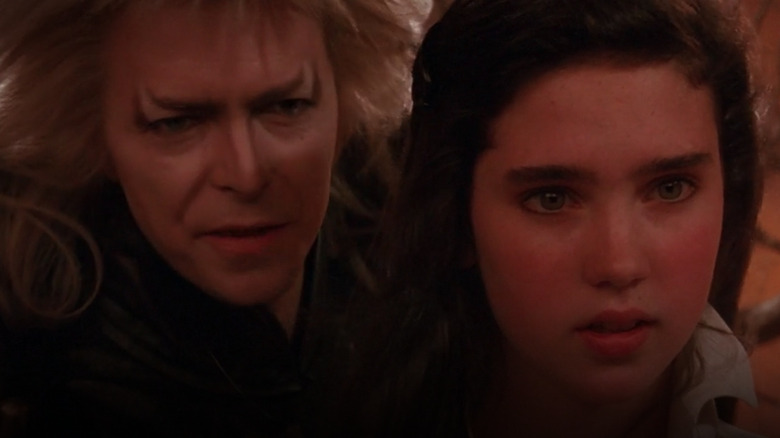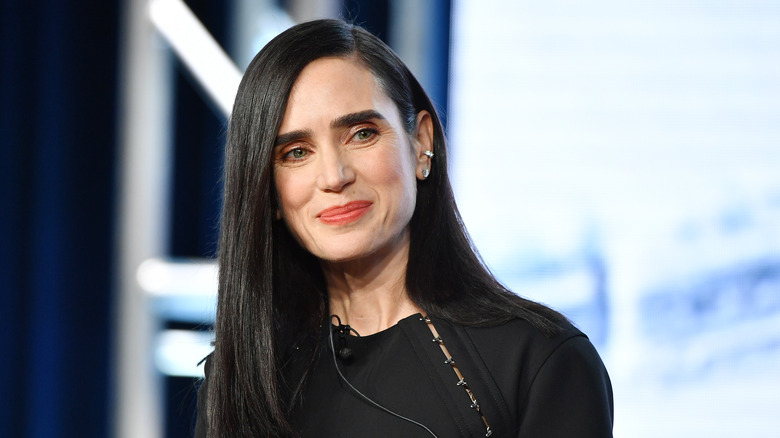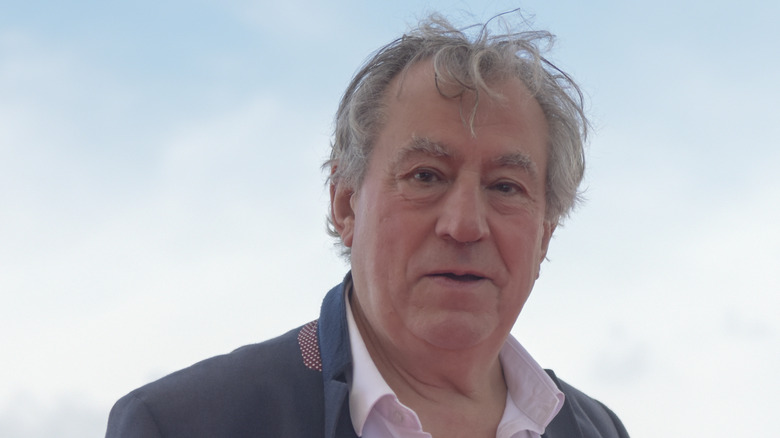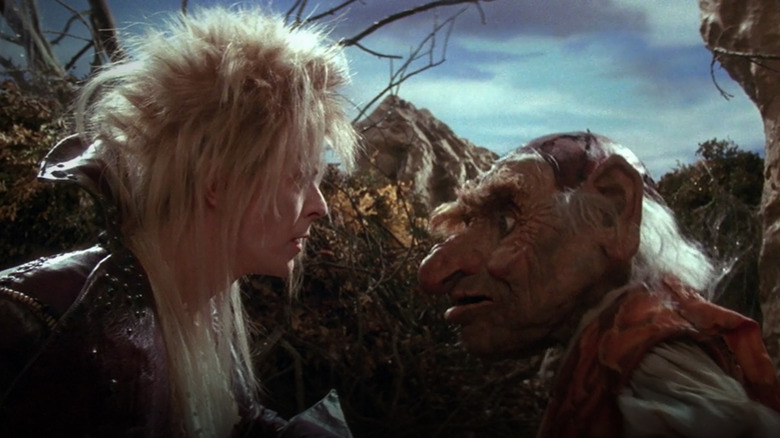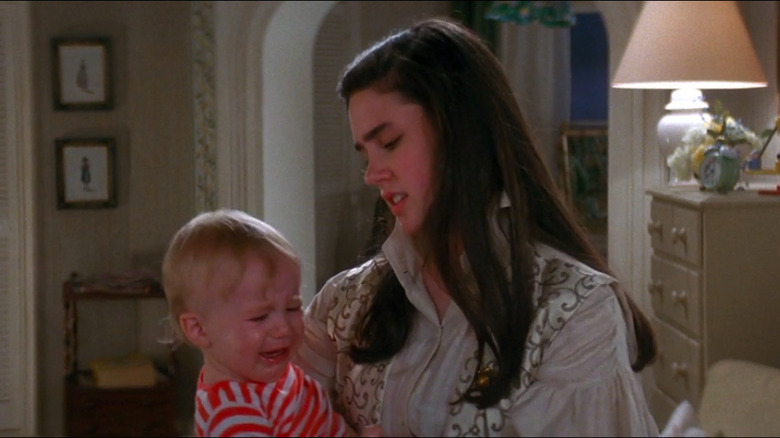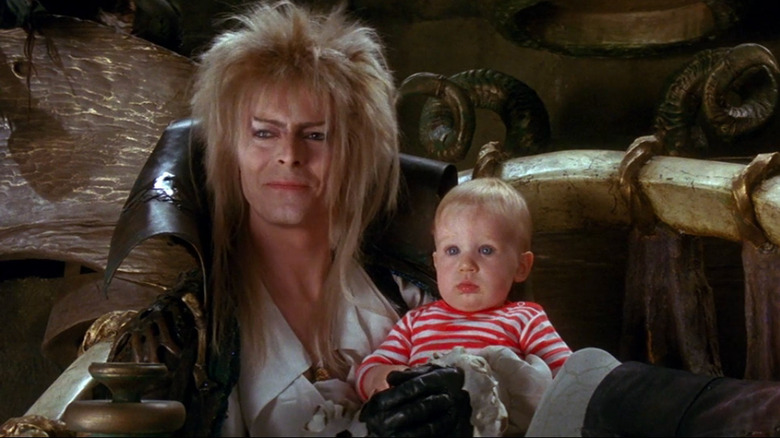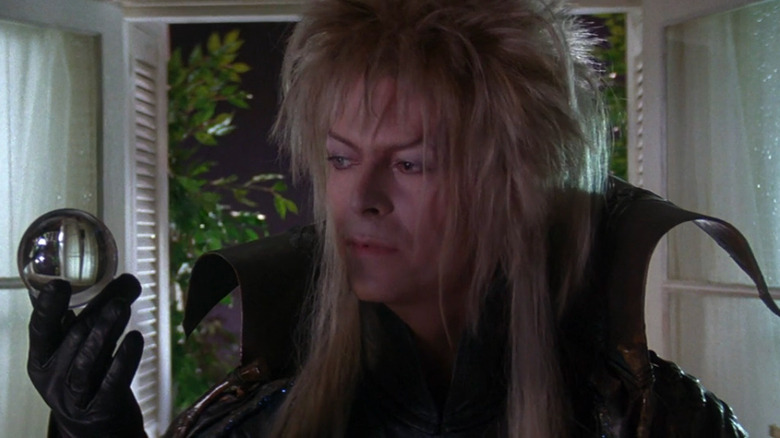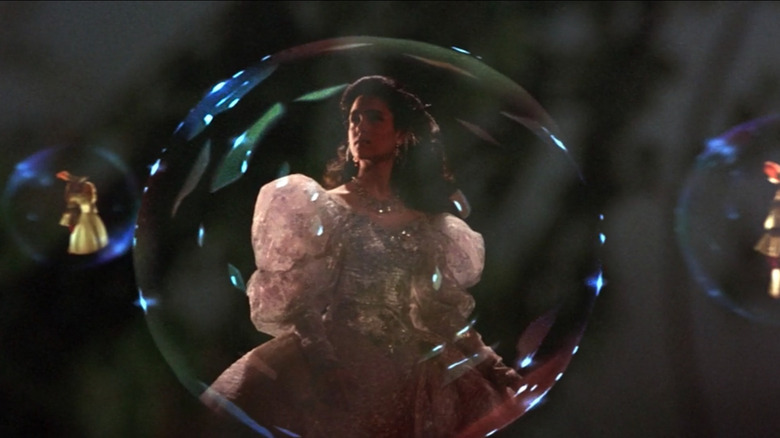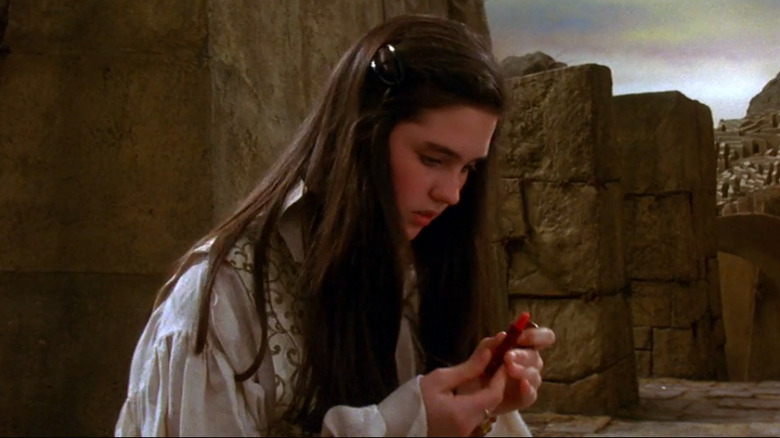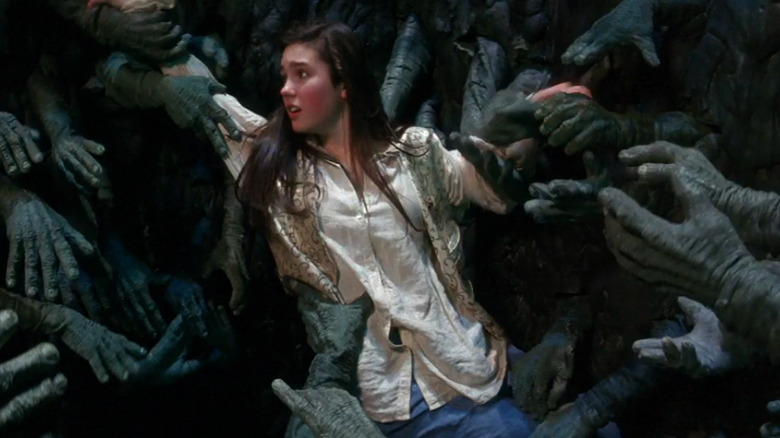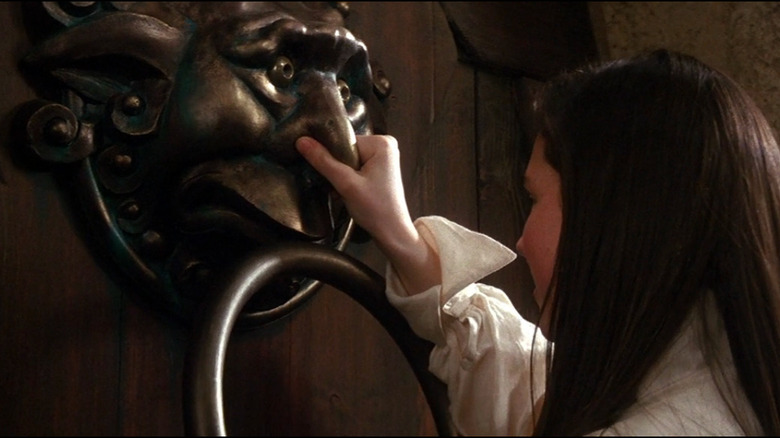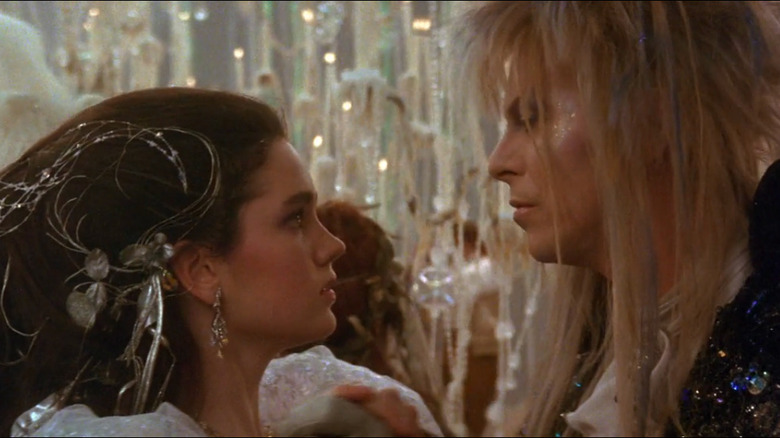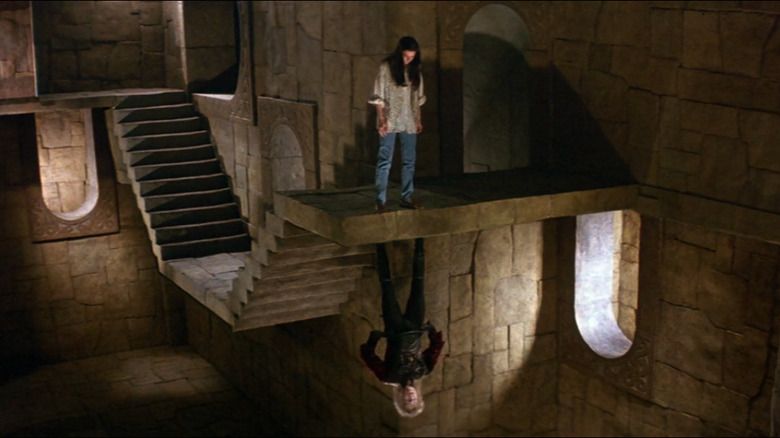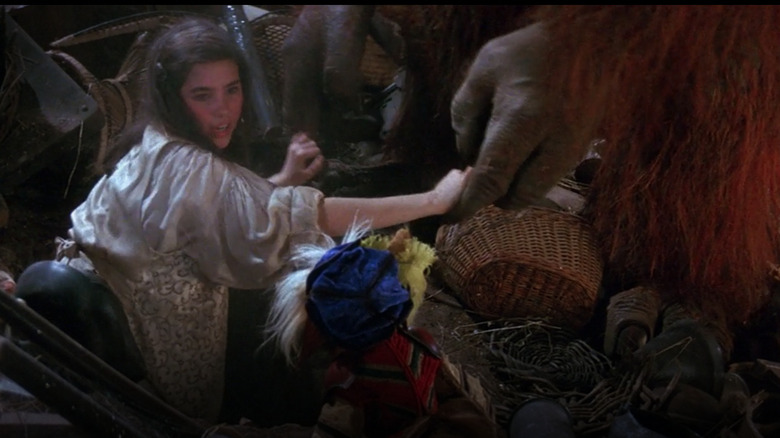Things Only Adults Notice In Labyrinth
2021 marked the 35th anniversary of Beloved fantasy-adventure classic "Labyrinth." The movie tells the tale of 16-year-old Sarah (Jennifer Connelly), who must rescue her baby half-brother Toby (Toby Froud) from the Goblin King (David Bowie) after accidentally wishing him away in a fit of frustration. To reach Toby, she must make her way through a huge labyrinth, which is full of confusing mazes and strange characters whose intentions aren't always what they seem.
Although the Jim Henson-directed and George Lucas-produced film did poorly at the box office when it was released in 1986, it garnered a legion of new fans after coming to home video and television. Today, "Labyrinth" is a cult hit and could be seen as ushering in a new era of fantasy stories focused on the trials and tribulations of adolescence. While many diehard fans may have initially seen the movie as kids, as adults they've likely found the story has only become richer. That's because there are quite a few things about "Labyrinth" only adults are likely to notice. Here are some of the most noteworthy.
Rock legend David Bowie plays the Goblin King
Many adults will recognize the voice singing the song over the opening credits of "Labyrinth" as that of pop culture icon David Bowie even before he appears in character as the Goblin King. Even today, Bowie remains one of the most famous performers in rock history — although unless they're music buffs, kids are unlikely to have much knowledge of Bowie or his legacy. While he may have been a highly influential figure in music in the 20th century, kids without a strong interest in rock and pop probably aren't aware of his body of work.
Of course, "Labyrinth" serves as a fantastic introduction to Bowie. His performance as the Goblin King continues to be one of his most beloved. And it's no wonder given, in his hands, the character exemplifies the rock star glam Bowie was so familiar with. Throughout his career, Bowie played with persona and identity, and although he was clearly playing a specific role in "Labyrinth," by depicting the Goblin King as an imperious pop star, he extended that tradition to the film, leading to a fascinating, infinitely interesting character — something only adults will fully grasp.
Future Oscar-winner Jennifer Connelly plays young protagonist Sarah
Jennifer Connelly landed the lead role of Sarah after an exhaustive search that saw all sorts of big names audition for "Labyrinth." In the end, Connelly beat out a bevy of future stars, including Jane Krakowski, Yasmine Bleeth, Sarah Jessica Parker, Mary Stewart Masterson, Laura Dern, and Lili Taylor. At the time, Connelly was only 14 years old and new to the entertainment business, but "Labyrinth" wasn't her first film. She had already starred in three other movies, although none of them created the lasting legacy that Henson's fantasy story did.
Of course, adults will know that Connelly went on to become a star and a respected actor who eventually won an Oscar for Best Supporting Actress for her work in 2001's "A Beautiful Mind." Today, Connelly tends to take roles in mature projects that kids aren't too likely to watch, so they may not realize just what an impressive career the girl who plays Sarah in "Labyrinth" has built for herself. The funny thing is Connelly looks relatively similar today to the way she did in 1986, making her highly recognizable, even for kids that only know her from the 35-year-old film.
A member of Monty Python wrote the screenplay
There are huge names behind the scenes of "Labyrinth" like George Lucas and Jim Henson that kids are likely to be familiar with, but one many youngsters may not recognize is that of Terry Jones, who is credited with writing the film's script. Terry Jones was one of the members of the groundbreaking comedy troupe Monty Python, and while the group's name may ring a bell with some kids, they're unlikely to realize Jones was an important part of it. Jones, who died in 2020, never had quite as high a public profile as other Monty Python members like John Cleese and Terry Gilliam. However, he was pivotal in shaping their comedy, and even directed or co-directed many of their movies, including "Monty Python and the Holy Grail." At the same time, he became a noted children's book author, which is likely why Henson wanted him to tackle the screenplay for "Labyrinth."
The irony, however, is that, although Jones is the only writer credited with penning the movie, there were over 25 versions of the script created between 1983 and 1985. Many of them weren't by Jones. In fact, it was a draft with changes by famed screenwriter Elaine May that was used during production. Because of all the differences from his original screenplay, Jones said in the book "Life Before and After Monty Python" that he "didn't feel ['Labyrinth'] was very much mine."
The Goblin King's given name is Jareth
While it's said throughout the movie, kids may not realize that the Goblin King's given name is Jareth. That's because the only one who consistently refers to him that way is Hoggle, and he uses the name in such a withering way that it's easy to find it more amusing than intimidating. As a result, there's quite a contrast between the funny image evoked by Hoggle's use of the name Jareth and the unnerving image evoked by the title the Goblin King, or even the goblins' proclamations of "Your Majesty." As a result, kids may miss the fact that when Hoggle mentions Jareth he's discussing the movie's glamorous bad guy.
On the other hand, many adults will notice the way the movie plays with our ideas about who "Labyrinth"'s antagonist is based on the distinction between mentions of his given name and his title. After all, Hoggle may find Jareth terrifying but we don't, while invoking the Goblin King makes our imaginations run wild.
Sarah isn't a very likable character
For kids who know they must eventually grow up but aren't sure they want to take on the responsibilities of adulthood, Sarah is a very relatable character. However, grown-ups are more likely to feel that her petulance, lack of consideration for others, and multiple pronunciations of "it's not fair" make her pretty insufferable. Sure, she has some good qualities, including intelligence, grit, and determination, but her immaturity makes it hard to really like her – especially early in the film.
It's possible if Sarah was younger, it would be easier to forgive her youthful peevishness, but at 16, Sarah seems a bit old to feel so put-upon. After all, this is a character who gets mad at her baby brother for taking her teddy bear and whose room is full of toys and children's books. This may all be good fuel for Sarah's clearly active imagination, but it seems odd that she hasn't moved on to more grown-up fare — after all, high school is when many fantasy-loving kids tackle the "Lord of the Rings" novels. Of course, today, 16-year-olds in pop culture tend to act like adults, which is often disconcerting too. It's not that adults would find Sarah more likable if she acted like one of them, but she would be easier to appreciate if she was starting to take on the responsibilities of a teenager, which should reasonably include looking after her baby brother.
The Goblin King's fixation on baby Toby is never completely explained
The mythology behind "Labyrinth" is clear: when someone wishes the goblins will take someone else away, the goblins happily grant their wish, removing the unwanted individual and making them a goblin too. Yet, what's not as clear is why Jareth, as the Goblin King, wants to add to his already vast legion of goblins. While he may be their king, Jareth seems to be human — and perpetually annoyed by the goblins he rules. So why would he want to turn Toby into one?
Despite this, Jareth does everything in his power to make sure he can keep baby Toby — first by offering Sarah her dreams to let Toby go, and then, when she rejects his offer, trying to thwart Sarah from saving her brother in any way he can. While kids probably won't question Jareth's motivations, many adults will recognize something doesn't quite add up here. Of course, Jareth may be bound to uphold the tradition of turning unwanted people into goblins to expand his kingdom. But since the movie never mentions it, it ultimately leaves a plot hole.
The music, costumes, and hair are very '80s
While kids may think the costumes and hair of the human characters in "Labyrinth" are in keeping with the strange fantasy land of the story, adults will know Jareth and Sarah's style is a product of the era when the movie was made. The 1980s had a distinct look and sound and the movie fully commits to it. Consequently, the costumes involve a lot of vests, flowy shirts, puffy sleeves, sparkles, and color. While Sarah's costumes are relatively understated for the time, the Goblin King's are consistently over the top — something that's especially obvious in his hair and make-up. With elaborate eye shadow and gravity-defying hair, Bowie's look in the film is both iconic and a perfect encapsulation of the style excesses of the decade.
The movie's '80s aesthetic extends to its music, including the score by Trevor Jones and the songs, which were written and performed by Bowie. Featuring a whole lot of electric guitar and synthesizer, the music is pretty dated. Bowie's songs, however, are jazzy earworms. "Magic Dance," in particular, is a silly yet memorable part of the movie that will have even modern-day kids dancing along.
It's never clear if the plot is real or Sarah's fantasy
From the movie's opening moments, Sarah's strong attachment to fairy tales and fantasy is obvious. And while kids may miss it, the play Sarah is rehearsing at the beginning of the film is called "Labyrinth," which strongly indicates that the plot of the movie is Sarah's fantasy come to life, informed by the play she's spent her time memorizing. Yet, the film slips so seamlessly from the real world of babysitting and responsibilities to that of goblins and mazes, that the land of "Labyrinth" comes across more like a real place than a fantasy.
Of course, that may be by design. For someone who's as imaginative as Sarah, the line between fantasy and reality may not be all that strong. Nonetheless, that lack of clarity leaves a lot for adults to interpret that kids are likely to overlook — including how each of the characters exemplifies Sarah's various fears and desires, and how the story itself is a metaphor for learning to accept more mature responsibilities.
Why would Sarah bring a tube of lipstick with her into the labyrinth
At one point in "Labyrinth," Sarah uses a tube of lipstick she finds in her pocket to mark the directions she'd taken through one the labyrinth's mazes. It's a smart plan. Unfortunately, what Sarah doesn't know is that the beings under the stone tiles don't want the uniform look of the maze to be ruined so they rotate and flip the stones as soon as she writes on them. Yet instead of focusing on Sarah's ingenuity or the way her plan is hopelessly foiled as kids likely will, adults may find themselves more preoccupied with why Sarah brought a tube of lipstick with her on her quest in the first place.
A 16-year-old wearing makeup isn't exactly unusual, so it's not a surprise that Sarah would own or use lipstick. However, Sarah was transported into the land of goblins directly from her home, and there's no reason she'd keep a tube of lipstick in her pocket while she's at home when she can easily access it in her nearby room. So while Sarah's use of the lipstick in her pocket works for the purposes of the story, from a practical standpoint it seems like a strange addition to the plot.
The hole in the ground with the helping hands is creative and kind of... handsy
At one point as Sarah makes her way through the labyrinth she falls down a hole. The scene is reminiscent of Alice falling down the rabbit hole at the beginning of "Alice in Wonderland," but in this case, the hole is lined with living, stony hands that catch Sarah before she hits the bottom. The hundreds of hands lining the hole and their penchant for coming together to form faces and talk is undeniably compelling. The sequence is a feat of creativity, one of the many things that make "Labyrinth" so captivating for both kids and adults.
At the same time, though, today it's hard not to look at all those hands gripping teenaged Sarah and think about matters of consent. After all, the hands may be stuck in that hole, but they're also touching a young girl without her permission. And given they appear to be conscious — and not particularly worried about where they're grabbing her — adults may find the sequence disturbing.
It's established that a talking door knocker breathes, but why does it need to?
After rescuing the hulking but adorable Ludo, Sarah encounters two wooden doors with knockers. Those knockers consist of metal faces with movable rings. One knocker has a ring attached to its ears, while the other has a ring stuck in its mouth, preventing it from talking. Sarah is looking for information on which door to choose, so she removes the ring from the knocker's mouth. Needless to say, the knocker has no desire to once again be responsible for holding the ring, so when Sarah decides she wants to replace it so she can knock on his door, the knocker resists. In order to get it to open its mouth, Sarah holds the knocker's nose, leaving it unable to breathe, which forces it to open its mouth.
Kids may not realize why Sarah held the door knocker's nose, while adults may find themselves wondering why what she did worked in the first place. After all, the face on the door doesn't even consist of an entire head, and it certainly doesn't have a body to go with it. So why does the door knocker need to breathe — and without lungs how is it doing so?
During Sarah's hallucination, the Goblin King's proclamations of love are inappropriate
There's a lot to love about "Labyrinth" but the relationship between the Goblin King and Sarah shades into unsettling at times. Essayist Alison Stine noted in The Atlantic that, from the movie's outset, Jareth clearly doesn't just want Toby: "He wants Sarah. He wants her to love him, and his longing increases, becoming more and more creepily clear, as the movie progresses. There's both a paternal appeal and stranger-danger in Jareth." As an adult, this is disconcerting, and no sequence in the movie is more disconcerting than the scene where Sarah imagines attending a masquerade ball.
Over a song about falling in love, the masked Goblin King makes a beeline for Sarah. And as they dance, the charge between them doesn't feel at all appropriate. Of course, for kids and even teenagers, the Goblin King's menacing magnetism may make him attractive. Adults, though, will recognize the disturbing undertones this evokes, and may find themselves pretty grossed out by this part of the story.
The room full of staircases in the castle is reminiscent of a work by M.C. Escher
When Sarah finally makes it to the Goblin King's castle, she finds herself trying to get to both Toby and Jareth in a room right out of "Relativity," one of M.C. Escher's most famous works. The black and white lithograph depicts a room full of staircases but only some seem to obey gravity, while others are upside down and sideways. Meanwhile, the people walking along the staircases and standing on the landings all seem to conform to different gravitational pulls. The idea Escher so vividly brought to life in his art is envisioned in live action in the scene in "Labyrinth."
This is something adults and possibly even some kids will notice instantly, although younger kids who haven't had much exposure to the world of art yet won't understand the reference. Still, there are clues in the movie that this is a deliberate homage. Not only does a print of "Relativity" hang on the wall of Sarah's room, the closing credits of the film include a special entry thanking the estate of M.C. Escher.
The movie has some good lessons about fairness, friendship, and overcoming hardship
Sarah may not be the easiest character to like, but she learns some valuable lessons during her adventures in "Labyrinth." These are lessons that kids may appreciate too, even if they won't be nearly as aware of them as adults will. Much of what Sarah learns centers on the realities of life when an adult isn't there to save you. For example, Sarah frequently complains that what she experiences isn't fair. But when Hoggle makes a similar complaint, Sarah realizes that he's right but sometimes life isn't fair and that's just the way it is. After that she stops complaining about whether things are fair, she faces the challenges of the labyrinth head-on, fair or not.
At the same time, by the end of the film, Sarah recognizes that even though her journey has left her more mature and capable, she still needs the friends she made along the way because they bring enjoyment and whimsy into her life. It's a smart but subtle lesson about the need to balance the responsibilities of adulthood with freewheeling fun every now and then, something even the most serious adult needs.
